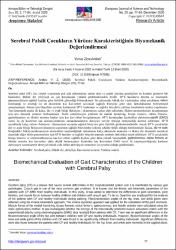| dc.contributor.author | Arslan, Yunus Ziya | |
| dc.date.accessioned | 2024-04-24T17:44:47Z | |
| dc.date.available | 2024-04-24T17:44:47Z | |
| dc.date.issued | 2020 | en_US |
| dc.identifier.citation | Arslan, Yunus Z. (2020). Serebral palsili çocukların yürüme karakteristiğinin biyomekanik değerlendirmesi. Avrupa Bilim Ve Teknoloji Dergisi (20), 77-84. | en_US |
| dc.identifier.uri | https://hdl.handle.net/20.500.12846/1145 | |
| dc.description.abstract | Serebral palsi (SP), kas iskelet sisteminde pek çok deformiteye neden olan ve çeşitli yürüme patolojileri ile kendini gösteren bir
hastalıktır. Bükük diz yürüyüşü en çok karşılaşılan yürüme problemlerinden biridir. SP’li hastaların kinetik ve kinematik
parametrelerinin sağlıklı kişilere göre farklılık gösterdiği bilinmektedir. Bu çalışmada, bükük diz yürüyüşüne sahip çocukların eklem
kinematiği ve kinetiği ile alt ekstremite kas kuvvetleri açısından sağlıklı bireylere göre olan farklılıklarının belirlenmesi
amaçlanmıştır. Bunun için OpenSim yazılımı kullanarak SP’li hastaların ve sağlıklı bireylerin yürüme hareketinin analizi yapılmıştır.
Ters kinematik analiz ile kalça, diz ve ayak bileği fleksiyon / ekstansiyon açıları elde edilmiştir. Eklem momentlerinin hesaplanması
için ters dinamik yöntemi kullanılmıştır. Statik optimizasyon yöntemi ile medial hamstring, biseps femoris, rektus femoris,
gastroknemius ve tibialis anterior kasları için kas kuvvetleri hesaplanmıştır. SP’li hastalardan kaydedilen elektromiyografi (EMG)
verisi ile de kestirilen kas aktivasyonlarının zamanlamalarının deneysel veriyle örtüşüp örtüşmediği kontrol edilmiştir. SP’li
çocuklarda kalça eklemi fleksiyon / ekstansiyon açısında sağlıklı bireylere göre farklılık gözlenmemektedir. Ancak SP’li çocuklarda
diz ve ayak bileği fleksiyon/ektansiyon açılarının sağlıklı bireylerden anlamlı şekilde farklı olduğu belirlenmiştir. Kalça, diz ve ayak
bileğindeki fleksiyon/ekstansiyon momentleri incelendiğinde maksimum kalça ekstansör momenti ve ikinci diz ekstansör momenti
dışındaki diğer bütün parametreler için SP’li hastalar ve sağlıklı bireyler arasında anlamlı farklılıklar tespit edilmiştir. SP’li çocuklarda
biseps femoris ve semimembranosus kas kuvvetleri sağlıklı kişilere göre daha yüksek bulunurken, gastroknemius, rektus femoris ve
tibialis anterior kas kuvvetleri daha düşük bulunmuştur. Kestirilen kas kuvvetleri EMG verisi ile karşılaştırıldığında kasların
aktivasyon zamanlarının deneysel olarak elde edilen aktivasyon zamanları ile uyumlu olduğu görülmüştür. | en_US |
| dc.description.abstract | Cerebral palsy (CP) is a disease that causes several deformities in the musculoskeletal system and it is manifested by various gait
pathologies. Crouch gait is one of the most common gait problems. It is known that the kinetic and kinematic parameters of the
patients with CP differ from healthy individuals. In this study, it was aimed to determine the differences in joint kinematics, joint
kinetics, and muscle forces between healthy children and children with crouch gait. To do so, OpenSim was employed for the analysis
of the patients with CP and healthy individuals during walking. Flexion/extension angles of the hip, knee, and ankle joints were
obtained using the inverse kinematics approach. The inverse dynamics approach was applied for the calculation of the joint moments.
Muscle forces of the medial hamstring, biceps femoris, rectus femoris, gastrocnemius, and tibialis anterior were calculated using the
static optimization method. It was investigated whether the timings of the theoretically predicted muscle activations match with the
experimental data by using electromyography (EMG) data recorded from patients with CP. There was no significant difference in the
flexion/extension angle of the hip joint between children with CP and healthy individuals. However, flexion/extension angles of the
knee and ankle joints of the children with CP were found to be significantly different from healthy individuals. Significant differences
were also found between the patients with CP and healthy individuals for the hip, knee, and ankle joint moments in the sagittal plane, except for the hip extensor moment and second knee extensor moment. While biceps femoris and semimembranosus muscle forces of
the children with CP were higher than those of healthy individuals, gastrocnemius, rectus femoris, and tibialis anterior muscle forces
were lower. The activation patterns of the calculated muscle forces were found to be compatible with the experimentally obtained
activation times. | en_US |
| dc.language.iso | tur | en_US |
| dc.relation.isversionof | 10.31590/ejosat.747998 | en_US |
| dc.rights | info:eu-repo/semantics/openAccess | en_US |
| dc.subject | Serebral palsi | en_US |
| dc.subject | Bükük diz yürüyüşü | en_US |
| dc.subject | Kas-iskelet sistemi | en_US |
| dc.subject | Yürüme analizi | en_US |
| dc.subject | Cerebral palsy | en_US |
| dc.subject | Crouch gait | en_US |
| dc.subject | Musculoskeletal system | en_US |
| dc.subject | Gait analysis | en_US |
| dc.title | Serebral palsili çocukların yürüme karakteristiğinin biyomekanik değerlendirmesi | en_US |
| dc.title.alternative | Biomechanical evaluation of gait characteristics of the children with cerebral palsy | en_US |
| dc.type | article | en_US |
| dc.relation.journal | Avrupa Bilim Ve Teknoloji Dergisi | en_US |
| dc.contributor.authorID | 0000-0002-1861-9368 | en_US |
| dc.identifier.issue | 20 | en_US |
| dc.relation.publicationcategory | Makale - Ulusal Hakemli Dergi - Kurum Öğretim Elemanı | en_US |
| dc.contributor.department | TAÜ, Fen Bilimleri Enstitüsü, Robotlar ve Akıllı Sistemler Ana Bilim Dalı Koleksiyonu | en_US |
| dc.identifier.startpage | 77 | en_US |
| dc.identifier.endpage | 84 | en_US |

















